Abstract
Radiologists play an important role in the diagnostic assessment of patients in the emergency setting. An acute abdomen in pregnancy represents one of the most challenging diagnostic and therapeutic dilemmas. The difficulty is due to the anatomical and pathophysiological changes related to pregnancy, including the different locations of abdominal and pelvic structures, displaced by the uterus, altered laboratory tests, difficult abdominal/pelvic physical examination, and non-specific symptoms. Physicians have to choose the appropriate imaging techniques in order to avoid, as much as possible, the use of ionizing radiation due to the potential risk for the fetus. Ultrasound is widely considered to be the first imaging examination that should be performed. Magnetic resonance imaging and computed tomography are used when ultrasound diagnosis is uncertain. In general, they are more accurate than ultrasound in the second and third trimesters. Magnetic resonance imaging is preferable to avoid ionizing radiation.
Access this chapter
Tax calculation will be finalised at checkout
Purchases are for personal use only
References
Casciani E, De Vincentiis C, Mazzei MA, et al. Errors in imaging the pregnant patient with acute abdomen. Abdom Imaging. 2015;40:2112–26.
Patlas MN, Dreizin D, Menias CO, et al. Abdominal and pelvic trauma: misses and misinterpretations at multidetector CT: trauma/emergency radiology. Radiographics. 2017;37:703–4.
Pinto A, Brunese L. Spectrum of diagnostic errors in radiology. World J Radiol. 2010;2:377–83.
Chang SD, Yen CF, Lo LM, et al. Surgical intervention for maternal ovarian torsion in pregnancy. Taiwan J Obstet Gynecol. 2011;50:458–62.
Masselli G, Derme M, Laghi F, et al. Evaluating the acute abdomen in the pregnant patient. Radiol Clin N Am. 2015;53:1309–25.
Lourenco AP, Swenson D, Tubbs RJ, et al. Ovarian and tubal torsion: imaging findings on US, CT, and MRI. Emerg Radiol. 2014;21:179–87.
Rothmund R, Taran FA, Boeer B, et al. Surgical and conservative management of symptomatic leiomyomas during pregnancy: a retrospective pilot study. Geburtshilfe Frauenheilkd. 2013;73:330–4.
Sohn GS, Cho S, Kim YM, et al. Working Group of Society of Uterine Leiomyoma. Current medical treatment of uterine fibroids. Obstet Gynecol Sci. 2018;61:192–201.
Sarkodie BD, Botwe BO, Ofori EK. Uterine fibroid characteristics and sonographic pattern among Ghanaian females undergoing pelvic ultrasound scan: a study at 3-major centres. BMC Womens Health. 2016;16:10.
Foti PV, Attinà G, Spadola S, et al. MR imaging of ovarian masses: classification and differential diagnosis. Insights Imaging. 2016;7:21–41.
Anthoulakis C, Nikoloudis N. Pelvic MRI as the “gold standard” in the subsequent evaluation of ultrasound-indeterminate adnexal lesions: a systematic review. Gynecol Oncol. 2014;132:661–8.
Mavromatidis G, Karavas G, Margioula-Siarkou C, et al. Spontaneous postpartum rupture of an intact uterus: a case report. J Clin Med Res. 2015;7:56–8.
Moini A, Hosseini R, Jahangiri N, et al. Risk factors for ectopic pregnancy: a case-control study. J Res Med Sci. 2014;19:844–9.
Petrides A, Dinglas C, Chavez M, et al. Revisiting ectopic pregnancy: a pictorial essay. J Clin Imaging Sci. 2014;4:37.
Lipscomb GH, Stovall TG, Ling FW. Nonsurgical treatment of ectopic pregnancy. N Engl J Med. 2000;343:1325–9.
RCOG. RCOG guidelines. Diagnosis and management of ectopic pregnancy (green-top guideline no. 21). London: RCOG; 2016.
Cacciatore B. Can the status of tubal pregnancy be predicted with transvaginal sonography? A prospective comparison of sonographic, surgical, and serum hCG findings. Radiology. 1990;177:481–4.
Brown DL, Doubilet PM. Transvaginal sonography for diagnosing ectopic pregnancy: positivity criteria and performance characteristics. J Ultrasound Med. 1994;13:259–66.
Nyberg DA, Mack LA, Jeffrey RB Jr, et al. Endovaginal sonographic evaluation of ectopic pregnancy: a prospective study. Am J Roentgenol. 1987;149:1181–6.
Masselli G, Derme M, Piccioni MG, et al. To evaluate the feasibility of magnetic resonance imaging in predicting unusual site ectopic pregnancy: a retrospective cohort study. Eur Radiol. 2018;28:2444–54.
Tamai K, Koyama T, Togashi K, et al. MR features of ectopic pregnancy. Eur Radiol. 2007;17:3236–46.
Leunen K, Hall DR, Odendaal HJ, et al. The profile and complications of women with placental abruption and intrauterine death. J Trop Pediatr. 2003;49:231–4.
Denis M, Enquobahrie DA, Tadesse MG, et al. Placental genome and maternal-placental genetic interactions: a genome-wide and candidate gene association study of placental abruption. PLoS One. 2014;9:e116346.
Jaffe MH, Schoen WC, Silver TM, et al. Sonography of abruptio placentae. AJR Am J Roentgenol. 1981;137:1049–54.
Harris RD, Cho C, Wells WA. Sonography of the placenta with emphasis on pathological correlation. Semin Ultrasound CT MR. 1996;17:66–89.
Yeo L, Ananth C, Vintzileos A. Placenta abruption. In: Sciarra J, editor. Gynecology and obstetrics. Hagerstown, MD: Lippincott Williams & Wilkins; 2004.
Masselli G, Brunelli R, Di Tola M, et al. MR imaging in the evaluation of placental abruption: correlation with sonographic findings. Radiology. 2011;259:222–30.
Verswijvel G, Grieten M, Gyselaers W, et al. MRI in the assessment of pregnancy related intrauterine bleeding: a valuable adjunct to ultrasound? JBR-BTR. 2002;85:189–92.
Atlas SW, Thulborn KR. Intracranial hemorrhage. In: Atlas SW, editor. Magnetic resonance imaging of the brain and of the spine. 4th ed. Philadelphia, PA: Lippincott Williams & Wilkins; 2009. p. 644–94.
Wu S, Kocherginsky M, Hibbard JU. Abnormal placentation: twenty-year analysis. Am J Obstet Gynecol. 2005;192:1458–61.
Comstock CH, Love JJ, Bronsteen RA, et al. Sonographic detection of placenta accrete in the second and third trimesters of pregnancy. Am J Obstet Gynecol. 2004;190:1135–40.
Comstock CH, Bronsteen RA. The antenatal diagnosis of placenta accreta. BJOG. 2014;121:171–81.
Lim PS, Greenberg M, Edelson MI, et al. Utility of ultrasound and MRI in prenatal diagnosis of placenta accreta: a pilot study. Am J Roentgenol. 2011;197:1506–13.
Derman AY, Nikac V, Haberman S, et al. MRI of placenta accreta: a new imaging perspective. Am J Roentgenol. 2011;197:1514–21.
Author information
Authors and Affiliations
Corresponding author
Editor information
Editors and Affiliations
Rights and permissions
Copyright information
© 2019 Springer Nature Switzerland AG
About this chapter
Cite this chapter
Masselli, G., Derme, M. (2019). Mistakes in Emergency Imaging of Pregnant Patients. In: Patlas, M., Katz, D., Scaglione, M. (eds) Errors in Emergency and Trauma Radiology. Springer, Cham. https://doi.org/10.1007/978-3-030-05548-6_10
Download citation
DOI: https://doi.org/10.1007/978-3-030-05548-6_10
Published:
Publisher Name: Springer, Cham
Print ISBN: 978-3-030-05547-9
Online ISBN: 978-3-030-05548-6
eBook Packages: MedicineMedicine (R0)

